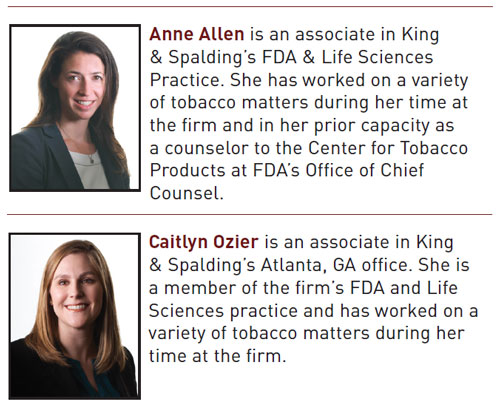
FDA’s Comprehensive Approach to Nicotine and Tobacco
by Anne Allen and Caitlyn Ozier
On July 28, 2017, Commissioner of Food and Drugs Scott Gottlieb, announced the U.S. Food and Drug Administration’s (FDA’s) multi-year comprehensive plan for tobacco and nicotine regulation as the agency intends to take on a new and comprehensive approach to nicotine. Commissioner Gottlieb acknowledged that there is a continuum of risk for nicotine delivery and a potential for innovation to lead to less harmful products as well as confront and alter cigarette addiction. FDA’s new policy represents a step forward in its tobacco regulation policy and will likely bring significant change in the coming years for regulated parties.
 As a general matter, FDA’s initial actions involve delaying current regulatory deadlines and conducting outreach and research to better inform the agency’s intended actions. Key parts of the comprehensive plan include FDA’s intention to delay certain deadlines regarding tobacco product applications for newly deemed products, as described in the May 2016 final Deeming Rule, 81 Fed. Reg. 28,974 (May 10, 2016), the agency’s plan to issue an advance notice of proposed rulemaking (ANPRM) regarding lowering nicotine in cigarettes, and efforts to obtain public input regarding the role of flavors in tobacco products. Below we analyze the key components of FDA’s comprehensive plan, as described in Commissioner Gottlieb’s speech and other communications with FDA.
As a general matter, FDA’s initial actions involve delaying current regulatory deadlines and conducting outreach and research to better inform the agency’s intended actions. Key parts of the comprehensive plan include FDA’s intention to delay certain deadlines regarding tobacco product applications for newly deemed products, as described in the May 2016 final Deeming Rule, 81 Fed. Reg. 28,974 (May 10, 2016), the agency’s plan to issue an advance notice of proposed rulemaking (ANPRM) regarding lowering nicotine in cigarettes, and efforts to obtain public input regarding the role of flavors in tobacco products. Below we analyze the key components of FDA’s comprehensive plan, as described in Commissioner Gottlieb’s speech and other communications with FDA.
A Delay to Provide Greater Clarity in Premarket Submission Requirements
Since 2009, FDA has worked to develop and implement a consistent premarket review process for tobacco products. With additional time to develop regulations, FDA hopes to establish a clear and reliable premarket review process.
In its announcement, FDA noted that it would publish a new guidance that would extend the timeline to submit tobacco product review applications for newly-regulated tobacco products that were on the market as of August 8, 2016. On August 10, 2017, FDA issued the aforementioned guidance detailing the new enforcement policy, Extension of Certain Tobacco Product Compliance Deadlines Related to the Final Deeming Rule. 82 Fed. Reg. 37,459. Under the revised timeline, the application deadlines for newly-regulated products are as follows: August 8, 2021 for combustible products, such as cigars and hookah tobacco; and August 8, 2022 for non-combustible products, such as electronic nicotine delivery systems (ENDS) or e-cigarettes. While the agency reviews these product applications, it intends to permit manufacturers to continue marketing the underlying products. FDA stated that it plans to use the intervening period from the extended deadlines to develop product standards that will protect against known public health risks, such as ENDS battery issues and children’s exposure to liquid nicotine.
FDA noted that it will also take steps to provide manufacturers with greater clarity on the premarket review process. Specifically, the agency plans to finalize the draft guidance, Premarket Tobacco Product Applications for Electronic Nicotine Delivery Systems (ENDS), that was issued concurrently with the final Deeming Rule. Additionally, FDA announced that it intends to issue regulations outlining the information applicants must include in premarket tobacco product applications (PMTAs), modified risk tobacco product applications, and substantial equivalence (SE) reports. FDA anticipates that, with additional time, guidance, and the implementation of a detailed regulatory framework regarding the content of premarket submissions, the submission process will be more efficient, predictable, and transparent, and manufacturers will be able to develop higher quality applications. To the extent that any product standard becomes effective before the new deadline to submit these applications, FDA expects that those product standards will be incorporated in the review of any submissions submitted after the effective date.
Manufacturers will be closely monitoring this process, as they have been awaiting concrete, detailed regulations on these submissions since Congress conferred tobacco regulatory authority on FDA in 2009. In the context of the current SE submission process, companies have relied on non-binding guidance and individualized feedback.
By promulgating regulations for premarket review applications, FDA stated that it hopes to bring clarity and consistency to the format, structure, and content of these applications, while upholding the agency’s public health mission. The rulemaking process will provide stakeholders with a chance to help shape submission requirements and the review process for premarket review applications. We therefore expect to see plenty of interaction and communication between FDA and stakeholders as the agency works to develop and finalize these rules before the delayed application deadlines arise in four and five years, respectively.
Stakeholder Engagement on Key Issues in Public Health
In addition to rulemaking and issuing guidance, FDA intends to issue ANPRMs on a number of topics to seek stakeholder input as it further hones its thinking. One of the proposed ANPRMs regards lowering nicotine in cigarettes to non-addictive levels. FDA stated that it will seek input on the potential public health benefits and any possible adverse effects of lowering nicotine in cigarettes, such as the potential for a black market for higher nicotine cigarettes. Ultimately, FDA said that it hopes to catalyze public dialogue about lowering nicotine levels in combustible cigarettes to minimally or non-addictive levels through achievable product standards. FDA noted that it is only considering nicotine reduction in combustible cigarettes and not in other tobacco products because combustible cigarettes are considered the primary cause of tobacco-related death and disease. See e.g., Scott Gottlieb and Mitchell Zeller, Perspective: A Nicotine-Focused Framework for Public Health, JAMA (Aug. 16, 2017).
The agency also plans to investigate flavors (including menthol) in tobacco products through an ANPRM. FDA intends to seek public input on the role that flavors in tobacco products play in attracting youth, as well as the role they may play in helping some smokers switch to potentially less harmful forms of nicotine delivery. In promulgating the final Deeming Rule, FDA chose not to issue a ban on all tobacco products with characterizing flavors at that time. 81 Fed. Reg. at 29,055. Rather, the agency stated that, based on available information regarding the growth of the flavored cigar market and its impact on youth and young adult initiation, it intended to issue a proposed product standard to prohibit characterizing flavors in cigars in the future. With regard to ENDS and other products, however, FDA cited a lack of adequate information regarding the potential public health benefits for adults looking to substitute non-combustible products for combustibles, and noted that it would seek additional data on the potential advantages of such characterizing flavors. Id.
In a potential reversal of its 2016 final Deeming Rule, FDA intends to seek public comment via ANPRM on the patterns of use and resulting public health impacts from premium cigars, which were included in FDA’s 2016 final Deeming Rule. FDA said that it seeks to determine whether and how it would exempt premium cigars from regulation. This matter was a major subject of debate surrounding promulgation of the initial deeming rule, and FDA ultimately chose to regulate premium cigars, stating, “[a]fter thorough review of the comments and the scientific evidence, FDA has concluded that deeming all cigars, rather than a subset, more completely protects public health.” 81 Fed. Reg. at 29,020. The agency went on to support its reasoning, suggesting that “all cigars pose serious negative health risks” and “the available evidence does not provide a basis for FDA to conclude that the patterns of premium cigar use sufficiently reduce the health risks to warrant exclusion.” Id. In rolling out its comprehensive plan, however, FDA includes this proposed ANPRM in the category of efforts to balance regulation and encourage the development of innovative tobacco products that might be less dangerous than cigarettes. Opponents of premium cigar regulation have suggested that the products should not be regulated because they are too expensive to appeal to youths, they are not consumed in the same way or at the same rate as other tobacco products, and their production process (typically handrolling) is fundamentally incompatible with FDA’s premarket review requirements given the lack of standardization in the resulting product. 81 Fed. Reg. at 29,020-27.
These ANPRMs are indicative of the agency’s priorities in the coming years. Stakeholders should use them to identify opportunities for research and to educate the agency on these issues in order to shape future regulatory policy.
Reassessment of Current Policies
Commissioner Gottlieb asked CTP to consider the Center’s current plan to review all provisional SE products, including whether this is an effective use of its resources. He asked CTP to determine whether the Center should continue to pursue the current approach to these reviews or (1) whether there is a more appropriate approach for provisional SE reports, (2) if the Center’s resources could be freed up for other purposes, and (3) whether greater clarity could be provided to the market. Director Zeller clarified that FDA is not, at this time, announcing any change in policy regarding provisional SE reports, but rather, will be reviewing those provisional SE reports that remain in the queue to determine from a public health and policy perspective whether they should remain in the queue or be removed. With the agency’s new focus on promulgating regulations for premarket review applications and potentially lowering nicotine in cigarettes via product standards, it remains an open question as to how pending provisional SE reports will fit into the new regulatory plan.
Concluding Thoughts
FDA’s new comprehensive tobacco and nicotine policy is dependent upon engaging industry stakeholders from all sides to assist in developing regulations and standards that are achievable and appropriate for the protection of public health. This comprehensive plan serves as a roadmap for stakeholders to understand FDA’s priorities and begin to develop and refine research to support their positions for each of these issues.
We note that FDA’s comprehensive nicotine compliance policy does not affect current requirements for cigarettes and smokeless tobacco products, provisions of the final Deeming Rule that are already in effect, and certain future deadlines for other provisions of the final Deeming Rule, including required warning statements, ingredient listing, health document submissions, harmful and potentially harmful constituent reports, and the removal of modified risk claims (i.e., “light,” “low,” or “mild,” or similar descriptors).
Update Magazine
September/October 2017









